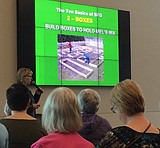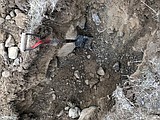Testing soils helps determine fertilizer needs
Mark Amara Wsu Grant-Adams Master Gardener | Hagadone News Network | UPDATED 7 years, 6 months AGO
Soil surveys, produced by the USDA Natural Resources Conservation Service, are accurate to tens of acres or more depending on the intensity of land use. Besides knowing soil type and its range of characteristics to determine what actual nutrients or fertilizers are needed in a yard or garden for healthy plants means doing some site-specific soil testing.
Soil should be tested about once every three to five years prior to planting. This is an easy way to learn about what fertilizers are needed and how much can be added. The types of lab tests that are run on a standard soil sample often include organic matter, pH (acidity or alkalinity), nitrogen, phosphorus, potassium, sulfur, and micronutrients like calcium, boron, magnesium, zinc, iron, manganese, and sodium.
Sample bags with instructions for collecting soils are provided by testing firms performing lab analyses on the samples and should be picked up ahead of time. Samples should be taken from the area to be planted. Avoid lanes or paths, corners or edges, areas between beds, wet or areas previously used for confining animals (such as chickens, horses, cows or other livestock), compost, rock, or weed heaps, or manure piles. Take samples from the 0-12-inch zone from several areas in the yard or garden or deeper depending on the rooting depths of preferred plants. Sample soils using clean shovels, trowels or augers and thoroughly mix materials in a clean bucket. Soil collected for testing should be devoid of undecomposed organic matter (manure, leaves, or grass, roots) and rock (of any size) that can contaminate a sample. Fill out the appropriate paperwork at the soil testing firm to determine costs.
Grant and Adams Counties soils often test low for nitrogen and sulfur, which are both soluble in water. This means these nutrients can leach away rather quickly with typical watering practices (or quicker with overwatering). Some of the trace elements (micro nutrients) like boron, zinc, and copper are also important to plant health. Many of our soils are on the alkaline side of the pH scale. If pH gets much above 8 gardeners should consider adding sulfur to bring the pH closer to 7, which is considered neutral and the optimum level for growing just about anything. High (above 8) or low pH (below 5) can tie up nutrients making them unavailable to plants so it is important to monitor soil often and find ways to maintain or improve conditions.
Our soils are low in organic matter. In the native condition, organic matter is at 1 percent or less. Ideally, the higher the organic matter (2-4 percent or more), the more healthy and productive soils become. Improving soils constantly with organic matter on an annual basis is recommended by incorporating plant residues, adding straw or alfalfa or other untreated materials like leaves and (pesticide-free) grass clippings, or planting cover and/or green manure crops. Adding manures should be minimized, as they tend to accumulate nutrients to excessive levels.
For example, when cow manure is added year after year to build organic matter, phosphorous can reach levels, which may be too high for many plants to endure. Then, it may be necessary to find ways to ameliorate these conditions like growing plants which help utilize the nutrients and help moderate its levels or avoid adding fertilizers with phosphorus. Similarly, growing plants on high pH soils can be done without amending it if you know what plants will tolerate higher pH. When blueberries are grown in eastern Washington soils must be amended to bring the pH down into the acid range because the plants will not produce well otherwise.
There is several soil testing firms in our area. The WSU Master Gardeners cannot recommend one firm over another and it is up to the gardener to check out possibilities and determine which one works best for their needs.
For answers to gardening questions, contact the Master Gardeners at the WSU Grant-Adams Extension office at 754-2011, ext. 4313 or email your gardening questions to [email protected]. Visit our web page at http://grant-adams.wsu.edu.
Extension programs and employment are available to all without discrimination. Evidence of noncompliance may be reported through your local Extension office. Requests for reasonable accommodations for persons with disabilities and special needs should be made at least two weeks prior to an event by contacting the WSU Grant-Adams County Extension Office at 509-754-2011, ext. 4313.
ARTICLES BY MARK AMARA WSU GRANT-ADAMS MASTER GARDENERÂ

Get to Know Your Soils Better
Getting to know the soils in the garden or yard can provide insights into what they consist of, what they are capable of producing, what their water holding capacity is, what they are best suited for, how they can be managed, and many other details.

Annual Columbia Basin Eco-Gardening Symposium taking signups
The Grant-Adams Master Gardeners and Grant County Conservation District is conducting a half-day gardening workshop at the Columbia Basin Technical Skills Center, 900 E. Yonezawa Blvd. in Moses Lake Saturday, April 21, from 9 a.m. to 1 p.m. The theme of the event is Swing into Spring.

Testing soils helps determine fertilizer needs
Soil surveys, produced by the USDA Natural Resources Conservation Service, are accurate to tens of acres or more depending on the intensity of land use. Besides knowing soil type and its range of characteristics to determine what actual nutrients or fertilizers are needed in a yard or garden for healthy plants means doing some site-specific soil testing.

